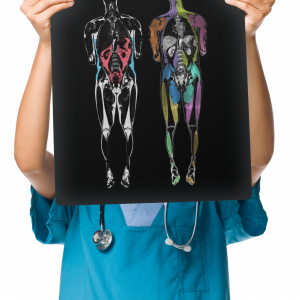AMRA Medical – Best Use of Digital Health FINALIST – 2018
SHORT DESCRIPTION
Global health care systems face unprecedented challenges associated with a rapid rise in obesity and metabolic disease, as well as conditions related to an ageing population. Research shows that a detailed understanding of the volume and distribution of fat and muscles in our bodies is vital to understanding and treating a variety of illnesses.
AMRA has introduced a new paradigm where rapid, 6-minute whole body MRI scans are analysed to produce precise, three – dimensional volumetric fat and muscle measurements. This standardized, automated method eliminates reader variability and reduces processing costs. AMRA also researches the relationships between fat, muscle and the development of disease, with the aim to become the new global standard in body composition. AMRA’s aim is also to support the precise tracking of treatment effects, the identification of who should participate in clinical trials, and the understanding of those who are at risk of developing disease.
AMRA is a young company with a recent $9m funding from Pfizer Venture Investments, Novo seeds and Industrifronden. Currently, it has global partnership agreements with two major MR vendors, GE Healthcare and Siemens Healthineers, as well as a clinical trial partnership with the leading imaging core group, BioTelemetry Research.
Application
Briefly describe the organisation giving number of facilities, staff, revenue numbers.
Founded in 2010; Headquartered in Linköping Sweden with additional offices in Stockholm, Oslo and US (4 total); 30+ employees; $1,089,400 Revenue in 2017
What is the nature of the service in which the organisation is using digital health?
AMRA is an international digital health company and the first in the world to transform images from a rapid, 6-minute whole body MRI scan into precise, 3D-volumetric fat and muscle measurements. Following the 2004 documentary, “Super-Size Me”, AMRA founders Magnus Borga and Olof Dahlqvist Leinhard began to investigate how MR imaging could be used to measure our bodies, including how specific fat and muscle groups in the body were affected by interventions such as the extreme diet changes seen in the documentary. Their research led to the development of a patented method for the automated analysis of MR images, the formation of AMRA, and to the research behind AMRA that is aimed at redefining obesity and metabolic risk. Headquartered in Sweden, AMRA was founded in 2010 as a spin-off of Center for Medical Image Science and Visualization (CMIV), the Department of Biomedical Engineering (IMT), and the Department of Medicine and Health (IMH) at Linköping University, Sweden. Our current customers include those working in clinical and academic research, as well as executive health / wellness care clinics, whereby we deliver either data output of individual fat / muscle volumes, or individualised reports showing an individual’s overall health and metabolic status. We have received CE Mark for clinical use in Europe and have recently submitted our 510K to the FDA – so we will soon head directly into the clinical market and patient care. AMRA’s mission is to confront our global health challenges by establishing the foundation for body composition measurement and providing the knowledge needed to predict and prevent diseases. The vision is a new, fundamental way of thinking about health. AMRA provides knowledge to the medical community so that every individual can become – and stay – healthy.
What is the nature of the digital health offering? Please describe the main IP component of this service.
AMRA was founded after the development a patented software, which allows for the precise and automated measurement of fat and muscles in the body based upon MRI images. The MRI images can be acquired from all major platforms (1.5T and 3T GE, Siemens, Philips), provided the machines are operating on fairly modern software versions. AMRA’s analysis software is not sold or licensed, so the business model is based upon a Cloud-based Software As A Service (SAAS). We focus upon the sale of our automated image analysis, which is based upon a per-analysis, per-study, or bulk model of sale. Our model is also aimed at partnerships for the indirect distribution of our service. For example, we have established a Global Co-Marketing Agreement with GE Healthcare, such that AMRA is now available in all latest GE MRI machines and those upgraded onto the latest MRI software version: the Dv26. We are currently establishing such agreements with both Siemens and Philips. Similarly, we also partner with pharmaceutical CROs and Imaging Core Labs for the widespread inclusion of our body composition imaging in clinical trials.
In brief, we know that BMI is inaccurate on an individual level. DXA (X-ray) is not precise when it comes to individual fat or muscle compartment measurement and has a mild degree of radiation exposure. BMI, DXA and Bioimpedance are impacted by fluid retention, meaning the results will vary as hydration of the body varies. Standard MRI is costly and time-consuming. Standard CT is cheaper, but uses ionizing radiation.
Ultimately, AMRA is the only company that offers a precise, individualised, holistic approach to understanding the relationships between fat, muscle, and the development of disease. AMRA offers markedly improved patient selection, saving time and money for companies by identifying individuals based upon their true body composition, rather than BMI or other indirect measure. The high precision of AMRA’s technology supports the early detection of treatment efficacy, the tracking the impact of interventions, and quantifying longitudinal changes in body composition, making it an ideal technology for clinical trials. As it continues to establish normal values and risk associations, AMRA has the potential to play a vital role in clinical and academic research – and eventually in patient management.
* High Accuracy & Precision
* Cost-Effective – 6-min scan, automated analysis, multiple measurements
* Standardized & Reproducible – Can be used across all major MRI platforms (1.5T and 3T GE, Siemens, Philips)
On a high level, AMRA’s patented technology is based on MR-Dixon imaging with continuous, overlapping slabs of axial 3D spoiled gradient multi-echo images. Water and fat images are calculated from the MR images using lipid models with T2*- correction. Phase-sensitive reconstruction is performed on the MRI scanner. The methods for body composition profiling of fat and muscle are based on:
– Image calibration to quantitative fat referenced images using adipose tissue as an internal intensity reference
– Labels of fat and muscle compartments are registered to the acquired volumes
– Quantification of fat and muscle volumes are done using a voting scheme
– Quality control of labels is performed by analysis engineers, and
– Quantification of fat and muscle volumes are based on the fat referenced images.
When did the organisation start delivering this service en masse?
- Month : Jan
- Year : 2014
What are the main key performance indicators? How does the organisation measure the success of the project?
As a small company, our success is measured by achieving key company milestones, which are related to revenues, operational growth across key business areas, further software development, the establishment of strategic partnerships / alliances, and overall marketplace visibility. For example, these are some of our key achievements over the past 12 months:
– Received $9M investment from Pfizer Venture Investments, Novo Seeds, and Industrifonden
– Finalist for the 2017 Clinical and Research Excellence (CARE) Awards as Best Patient-Focused Technological Development.
– Participated in the European Congress of Obesity with first industry symposium and 3 abstract acceptances / presentations
– Expanded into the US with its first US-based employee. AMRA now has a business development team of three people in the US.
– Entered into the clinical trial space by operating in its first clinical study
– Signed two company partnership deals: Biotelemetry Research for NAFLD / NASH clinical trials, and Artialis, for sarcopenia clinical trials
– Established two of the top 5 global pharma companies as customers
– Received CE mark for clinical use in Europe. We also submitted a 510K for FDA Clearance.
– Listed as one of Europe’s Top 20 Health & Medtech Start-ups in 2018
– Global Co-Marketing Agreements with 2 out of the 3 largest MRI vendors
– High number of top-class publications published and abstracts presented at several conferences
– Launched new Metabolic Scientific Advisory Board
– Partnered with Human Longevity Initiative (HLI) to have body composition profiling including in Health Nucleus
– Completed and returned the body composition analysis of 6,000 people into the UK Biobank, so the data is available now to researchers worldwide
– Changed the company name, launched a new domain (AMRA Medical)
How has the digital health enabled service impacted on patient/care recipient outcomes?
Globally, 2.1 billion are characterized as overweight or obese. By 2050, the ageing population – those over 60 years – will also surpass 2 billion. Our greatest health challenges are thus related to obesity and ageing, both of which are impacted by body composition and fat distribution. It is well-known that total body fat is less important than where it is. For example, fat in the abdomen – visceral fat – has high associations with diabetes, heart and liver disease, and cancer. In addition, our elderly are greatly affected by muscle loss and increased fat, a debilitating condition known as sarcopenia. To understand our bodies today, we use BMI, which cannot measure fat, muscles, or their distribution. BMI holds value at a population level, but doesn’t provide the accuracy or precision needed to be successful individually. However, our medical communities rely on this simplistic, indirect measure to characterize individuals, assess disease risk and determine individual treatments. AMRA is the first in the world to transform images from a 6-minute whole body MRI into 3D-volumetric fat and muscle measurements delivered via an automated, cloud-based analysis service. To confront our global health challenges, we need a new standard in body composition assessment – a precise, cost-effective way to understand our bodies far beyond what is available today. Thus, AMRA originated with precision medicine in mind, aimed at supporting therapeutic investigation and, soon, patient care.



